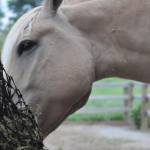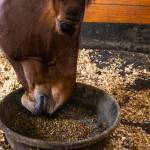Limited Forage Intake and Horse Behavior

Drylots are sometimes employed by horse owners to keep their easy keepers in moderate body condition. Considering pastured horses spend approximately 16-18 hours each day grazing, what do horses on drylots do with their time?
“Some horses require less forage than others and may therefore inhabit paddocks that contain a lower volume or density of forage,” noted Kathleen Crandell, Ph.D., a nutritionist for Kentucky Equine Research.
Limited forage intake might be appropriate for:
- Horses with metabolic conditions, such as equine metabolic syndrome and insulin dysregulation, as they should be allowed access to forage with no more than 10% nonstructural carbohydrates;
- Laminitic horses, particularly chronic cases, which benefit from forage-only diets and from mediocre-quality forage, both meant to decrease the likelihood of a flare-up;
- Horses with osteoarthritis, which profit from weight management that would strip superfluous weight and relieve pressure on inflamed joints; and
- Even “healthy” overweight horses can benefit from decreased grazing to avoid or delay development of metabolic issues.
“On the flip side, horses with decreased intake may be at risk for the development of gastric ulcers, particularly those in the upper part of the stomach, a syndrome referred to as equine squamous gastric disease,” advised Crandell. “Additionally, horses might also be at risk of developing stereotypies such as cribbing.”
Further, although weight management for arthritic horses is important, affected animals must be able to move to keep joints lubricated.
To gain a better understanding of what horses do on restricted pasture, researchers from Western Kentucky University* evaluated how horses “budget” their time and compared those actions to horses on unrestricted pasture. They found that horses on restricted pasture lost weight, as hoped, yet still spent a substantial amount of their time grazing or attempting to graze restricted pastures. The remainder of their time was spent simply standing or engaging in other behaviors.
“The time budget of the horses on restricted pastures was altered from that of horses with unrestricted access to grazing, which may raise some behavioral and physiological issues,” Crandell suggested.
For nutritional consultation and suggestions on how best to manage your horse’s diet, especially when restricted pasture is warranted, consult a Kentucky Equine Research nutrition advisor today.
*Gartland, B.A., V.J. Willis, H.E. Maupin, et al. 2019. Time budgets in horses during continuous and space-restricted rotational grazing. Journal of Equine Veterinary Science 76:39-65.








